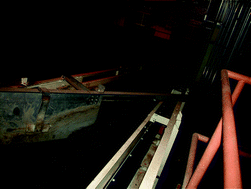The development of a high-throughput method for the analysis of 14 endocrine-disrupting substances in environmental solid matrices has been investigated. Selected compounds were: hormones (estrogens and progestogens), parabens and triclocarban. The ultrafast method (15 s per sample) is based on the laser diode thermal desorption-atmospheric pressure chemical ionization (LDTD-APCI) coupled to tandem mass spectrometry (MS/MS). This novel approach was tested and validated in three different solid matrices (municipal sludge cakes, aquatic sediments and agricultural soils) and its performance was evaluated by estimation of extraction recovery, linearity, precision, and detection limits. In contrast to other methods based on LC-MS/MS, a cleanup step is not necessary or minimal for the municipal sludge cake matrix. Extraction recoveries ranged from 80 to 109% for all compounds in all matrix types except for estriol which was 60–75%. The intra- and inter-day precisions, as indicated by % RSD, were ≤14% and ≤16%, respectively. The method detection limits ranged from 0.7 to 4.0 ng g−1 in sediments and soil matrices and 2.8 to 16.8 ng g−1 for municipal sludge cake samples. The results for real environmental samples collected in different areas of Quebec (Canada) are illustrated.

You have access to this article
 Please wait while we load your content...
Something went wrong. Try again?
Please wait while we load your content...
Something went wrong. Try again?


 Please wait while we load your content...
Please wait while we load your content...